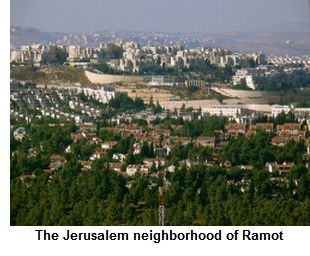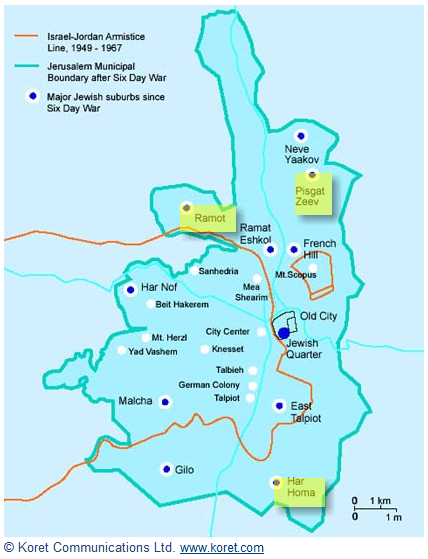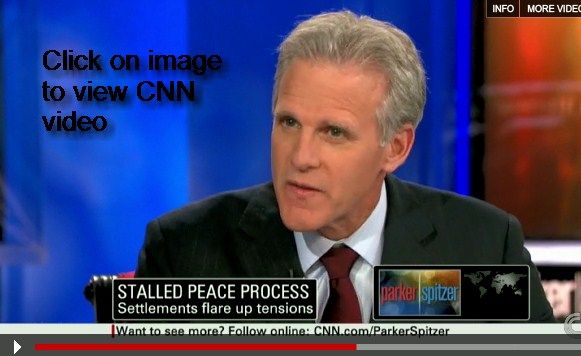 Once again, the issue of Israeli building in Jerusalem is making headlines threatening a full-blown crisis. But just how accurate are those headlines?
Once again, the issue of Israeli building in Jerusalem is making headlines threatening a full-blown crisis. But just how accurate are those headlines?
Settlements are not a consensus issue both within and outside of Israel. However, it is incumbent upon the media to present the facts and the necessary context in order for readers to understand the reality of the situation and to allow for an informed judgment. Unfortunately the media has to a large extent failed.
What is “East Jerusalem”?
According to The Guardian:
The East Jerusalem plans cover almost 980 new homes in Har Homa, 320 in Ramot and 32 in Pisgat Ze’ev, all situated on the Palestinian side of the Green Line.
Meanwhile the Daily Telegraph doesn’t even bother to add any geographical reference, merely referring to:
new settler homes in East Jerusalem, captured and later annexed by Israel after the Six Day War of 1967.
McClatchy Newspapers speaks of:
1,300 new homes for Jewish settlers in largely Arab East Jerusalem.
Considering the huge number of foreign journalists actually based in Jerusalem, it is misleading to use catch-all terms such as “settlements” or “Arab East Jerusalem” to refer to the geography of Israel’s capital city. The uninformed reader is left with the simplistic notion that Jerusalem is clearly divided down the middle between Jews in the west and Palestinians in the east and that the Israeli building is physically encroaching on Arab neighborhoods.
The reality is quite different. Modern-day Jerusalem is a patchwork of both Jewish, Arab and mixed neighborhoods with no restrictions on Arab residents moving into predominantly Jewish neighborhoods in any part of the city. Indeed, there is an increasing number of Arabs moving into Pisgat Ze’ev, one of the locations included in the building plan.
In fact, the only time that the eastern part of Jerusalem was exclusively Arab was between 1949 and 1967, and that was because Jordan occupied the area and forcibly expelled all the Jews.
All three locations where building is proposed are established Jewish neighborhoods located within Jerusalem’s municipal boundaries and are not located on “Arab land”. The description of “East” Jerusalem is also something of a misnomer. Ramot and Pisgat Ze’ev, built in the 1970s, are in the north of the city while Har Homa is in the south.

Some media did not refer to “settlements”, instead offering a slightly more nuanced description:
-
“two neighborhoods in West Bank areas annexed to Jerusalem after the 1967 war” – Washington Post
-
“disputed East Jerusalem”; “1,300 more Jewish housing units in East Jerusalem” – LA Times
Some media, such as CNN, stated that:
Israel differentiates the settlements from the West Bank, the land seized from Jordan in the 1967 war, from the housing in the politically undivided city of Jerusalem.
Too many media outlets, however, failed to differentiate despite the fact that many of their own correspondents are living in Jerusalem and are fully aware of the difference. To fail to include this differentiation and relevant context is misleading and faulty journalism.
No “New Settlements”
Despite the fact that the new homes are planned for existing Jewish neighborhoods of Jerusalem, some media have falsely portrayed Israel as building entirely new “settlements”.
-
Furious Jews heckle Israeli PM at speech in U.S. over fears that new settlements will ruin fledgling peace talks – Daily Mail
-
New Israeli settlements provoke critics – Sydney Morning Herald
-
Israel shrugs off Obama’s criticism of new settlements – McClatchy Newspapers
-
Obama-Netanyahu honeymoon ends as Israel builds more settlements – The Times of London (subscription only)
The Status of Har HomaDespite Har Homa’s location within the municipal boundaries of Jerusalem, the Financial Times refers to the neighborhood as “a settlement south of Jerusalem”. As the Jewish Virtual Library notes:
The entire area of Har Homa is less than 460 acres. When the project began, it was completely vacant and is not adjacent to any Arab population.
The original decision to go forward with construction on Har Homa was made by Labor Prime Minister Shimon Peres in 1996; construction did not proceed because the issue was tied up in Israeli courts. The Israeli Supreme Court rejected appeals by both Jewish and Arab landowners and approved the expropriation of land for the project. The expropriations were undertaken on the basis of the fundamental common law principle of eminent domain, allowing governments to expropriate land from private owners for public use. Most of the land — 75% — was expropriated from Jews.
Jerusalem is Not a Settlement
While the issue of West Bank settlements is not a consensus issue within Israel, the status of Jerusalem as the eternal, indivisible capital of Israel and the Jewish people falls well within the mainstream. While this does not necessarily preclude territorial or political compromises in any future peace negotiations, Israel has never agreed to curtail building within its capital city. The residents of Jewish neighborhoods certainly do not see themselves as “settlers”.
Previous peace talks have not been impeded by construction and every Israeli government since 1967 has supported building in the capital.
Israel’s Ambassador to the US, Michael Oren explains to CNN the realities governing Israeli policies towards building in Jerusalem and why such building should not impact on any eventual peace process or agreement:
Israel is a country where buildings are constructed after going through the proper procedure for planning permission. The 1,300 proposed homes that have created a media and diplomatic storm are still very much on paper and may be a number of years away from actual fruition. The current proposals are not new and are at the early stage of the planning process.
Take Action Now
Read the coverage in your local media and note the linguistic nuances and context or lack of that appears in the story. Language and context are important. Israel has always differentiated between Jerusalem, its capital city, major settlement blocs e.g. Gush Etzion, that are expected to remain in Israeli hands following a peace deal, and the more isolated settlements that may or may not be evacuated as part of a peace deal. Indeed, Israel has proven itself willing to evacuate settlements as in the case of the 2005 Gaza disengagement.
Send letters to the editors and demand that the media, irrespective of editorial views on the issue, reports fairly and accurately to properly inform their readership.



